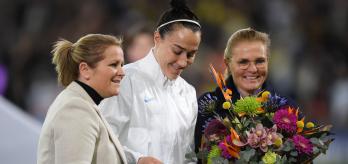“I think a high-performance environment involves creating a really ambitious goal and a really ambitious vision in which everybody is connected to and shares the same excitement,” explains Cossington, who recently left The English Football Association to become Lead of Women’s Football at Sixth Street investment firm and Chief Executive of Bay Collective, a multi-club global organisation.
“As part of that, everybody must be really clear on what their roles and responsibilities are in terms of achieving that ambition. It’s about clarifying what our roles and responsibilities are in terms of our work streams and our work programmes. I think it’s really important to understand what we do and what we don’t do.”
Recognising and celebrating everybody’s role in success
Role clarity can help “build and drive” a thriving culture in which each department’s contribution is recognised and celebrated, says Cossington. “At the English FA we wanted to ensure that every department had a really clear understanding of what the department goal was, what their role was in achieving that and how that linked to the bigger picture” explains Cossington.
“For example, when we won the European Championships, it wasn’t just the team that won, it was the whole division that won. Everybody that played a part in all of those players’ journeys, whether it was the operations team, content team and many, many others, everybody played a part in those players going out and performing on the pitch. We wanted to recognise and get people to understand the part they actually played. Role clarity was integral to building and driving a really thriving culture.”
Building the plan together
Adopting a collaborative approach to the development of organisational strategy can help individuals and teams foster a greater sense of both understanding and ownership, believes Cossington. “I think it’s really important to build a plan together with your staff,” says Cossington. “I could sit in a dark room and drive something myself and give it to someone, but the staff wouldn’t have ownership of it, they wouldn’t have clarity on what that is and they wouldn’t feel like they belong in that place.”
Building a plan together and clearly outlining goals, is a key process in terms of developing accountability and responsibility, believes Cossington. “We had a phrase around ‘keeping in your lane,’ which involved doing what's right in your lane before dipping into somebody else's lane,” she explains. “It also involved completing your work at the absolute highest level with no stone left unturned before you dip in and help someone else in another lane.”
Outlining “fast and slow lane” priorities
Outlining short-term and long-term priorities is a key part of developing a strategic plan in which each individual understands their roles and responsibilities, says Cossington.
“We spent many hours collaborating around what's important in the different domains of different departments and how this is going to influence and impact the short -term and what are the things that we actually think are going to be longer term.
“For each department we did a really simple exercise looking at the first 12 months as well as year two and three. We used flip charts and decided where we were going to place projects across those different years and that really aided the conversation and discussion. By the end of that period of time we had funnelled down our priorities and our fast lane work.”
Agreement on the order of objectives was achieved by involving all teams within the department in the decision-making process, says Cossington. “I was always conscious and I said to the staff by the time we walk out of this room we need to be clear on what it is we're going after and we all need to be on the bus with that and we need to stick to it and I think that was one of our real big learnings.”













